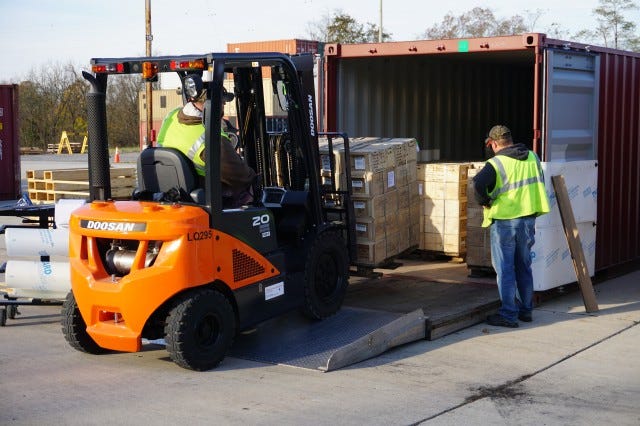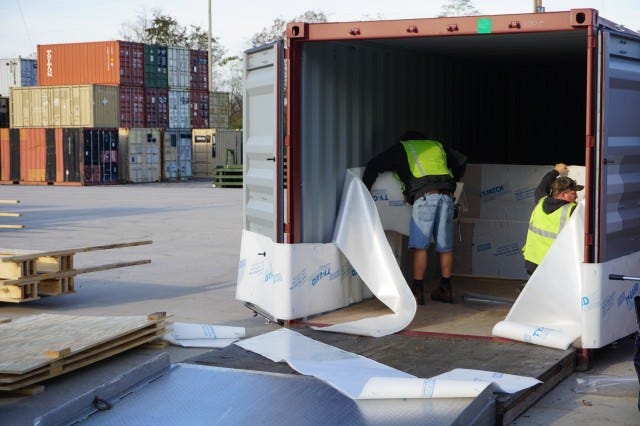Blocking and Bracing Ammunition
One of the most practical ways to transport munitions is using the Twenty-foot Equivalent Unit (TEU). Which is a shipping container with dimensions measuring about 20 feet long, 8 feet wide, and 8 feet tall, that can hold about 8 to 10 pallets, depending on the type of pallets. While unit cargo movements, completed by unit movement officers (UMO) for deployment operations, container inspections focus on proper securement and documentation. Units use shipping materials needed for containers, such as 4-feet by 8-feet sheets of 3/4-inch plywood, required for the general inspection of all packed containers. The fastening is known as blocking and bracing, a way to secure material in a container, on a skid, or in a conveyance such as a truck or a railcar.
· Blocking uses cut pieces of dimensional lumber, typically fastened to the inside of a container. To block the product in place, prevent shifting from side to side or front to back during transit.
· Bracing prevents lateral movements within a container and is secured to the interior walls or the inside top of a container.
Figure 1. Shipping container containing ammunition.
Military ammunition and explosives require extreme care and handling during shipments to protect against accidental explosion. Military units must use established and approved procedures to ensure that loads of ammunition and explosives are transported safely. The Department of Defense Standard Practice for Designing Unit Loads, Truckloads, Railcar Loads, And Intermodal Loads for Ammunition and ExplosivesMIL-STD-1320D establishes standard guidelines to document designs and the assembly of ammunition loads.
Each type of load used to move ammunition and explosives needs documents, such as drawings or equivalent diagrams used to define the procedures and methods for building loads. Each branch of the U.S. military has activities with authority to approve loads. The approval authorities are in figure 1.
Figure 2. Approval activities.
The approval authorities can develop loads and create independent load documents for transport situations not covered under the military standard. But most loads will fall under the following categories.
· Unit loads. Unit loads are composed of two or more items fixed firmly together to make a single unit generally supported on a pallet.
· Truckloads. A detailed plan provides instructions for assembling the load, tiedown blocking, and bracing methods needed to secure it on a truck.
· Railcar loads. A document detailing the loading, tiedown method, blocking, and bracing needed to secure the load in a boxcar or on a flatcar.
· Intermodal container loads. Loads that utilize a specially designed container to facilitate movement by one or more modes of transportation without requiring reloading.
· Document of load plans. Standard documents used by U.S. Army in drawings AMC 19-48-75 or U.S. Navy drawings and procedures approved by the other services.
The downside of using blocking and bracing is the cost of lumber per container and the more time required to complete each container with more complex load plans. Joint Munitions Command conducted a feasibility trial for potential reduction in cost, time, and resources over the traditional lumber method for shipping. The military command used Ty-Gard, which is an approved method to secure dangerous goods. Ty-Gard supplemented the use of lumber for securing munitions for shipping but did not eliminate all the need for lumber. Time studies were conducted on both the original blocking and bracing and the new Ty-Gard method.


Figure 3. Ty-Gard for securing.
Blocking and bracing to transport ammunition shipments are required to protect against accidents. Safe transportation is essential and can be done through blocking, bracing, or Container Roll-in/Out Platform (CROP). While other methods are under development, each has its advantages and disadvantages. Whichever methods are chosen, the purpose and mission at hand will dictate how munitions will need to move from industrial base to port of debarkation, and with the opportunity, forward to division or corps support areas.
Resources:
International Shipping Logistics and IMO/Ammunition & Explosive Cargo https://cainalongbranch.com/shippinglogistics.html
Letterkenny Munitions Center studies new blocking and bracing technique https://www.army.mil/article/213694/letterkenny_munitions_center_studies_new_blocking_and_bracing_technique
Nationwide Move 15 showcases unique, historic, multi-component ocean-transport mission https://www.army.mil/article/154590/nationwide_move_15_showcases_unique_historic_multi_component_ocean_transport_mission
Projectile, 155MM, XM982, Excalibur, Packed One – DTIC https://apps.dtic.mil/dtic/tr/fulltext/u2/a487001.pdf
Southern Bracing Systems Cargo Securement Specialists Ty-Gard



